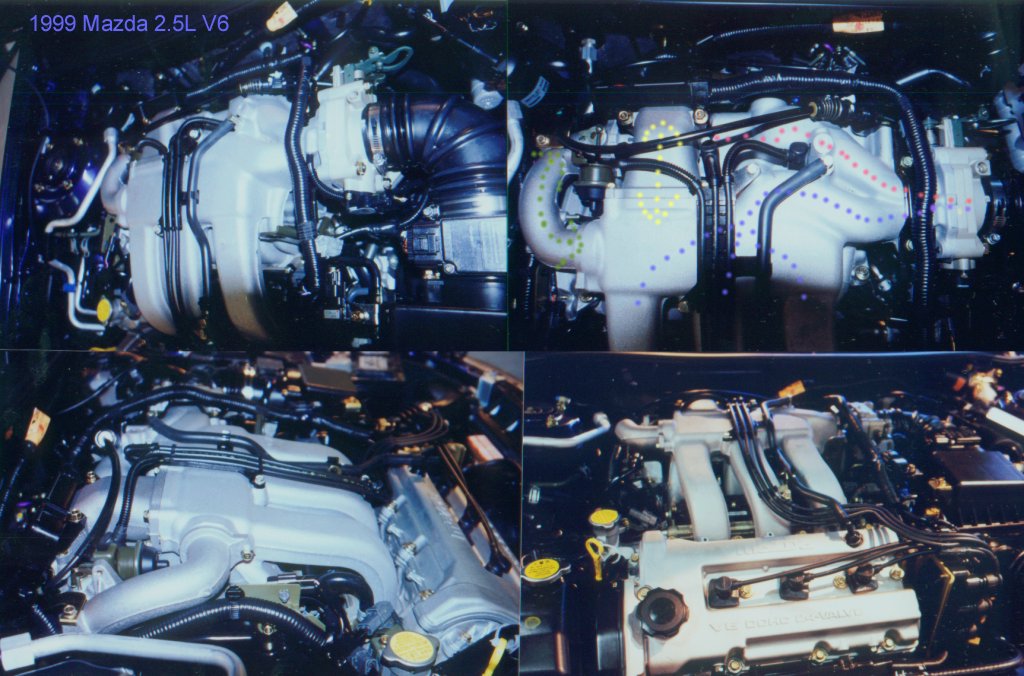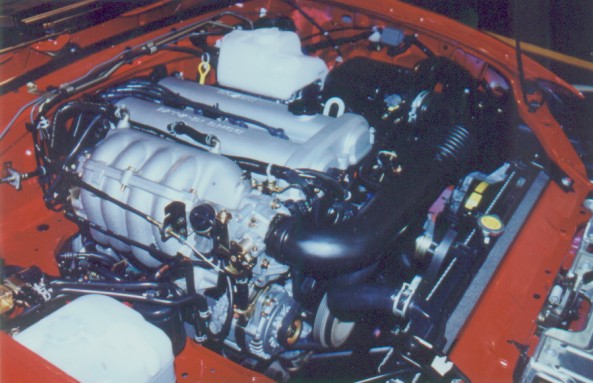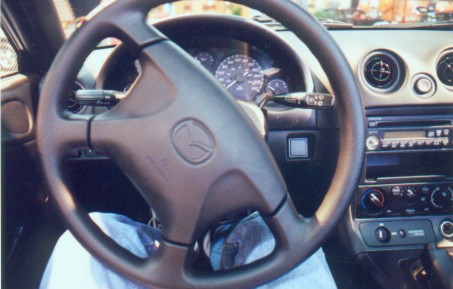
PROBE GT GLOSSARY -- Back
1999 Canadian International Auto Show
February 22, 1999 The Canadian International Auto Show is a farce compared to some of the giant shows like Detroit, Tokyo, etc. However,
it is adequate if you are only a semi-serious car buff. Here are some quick shots that I took. You'll probably notice that my focus at the show was not on the typical things people
usually want to see at the shows. Intake Designs Here's a shot of the latest Mazda 2.5L, the successor to the KL03. It pumps out 170HP. A few elements of the KLZE
manifold were borrowed, namely the thick resonance tube (indicated with yellow dots) that is used at high RPM's. I have
marked the medium RPM resonance tube with the green dots. For more info on how the whole resonance thing works,
see VRIS Heaven. The pink and blue dots show the intake passages for the rear and front banks respectively. A neat
thing about this engine is the fact that a mass airflow sensor has replaced the vane airflow sensor of the past.

Like the Mazda 2.5L, Chrysler's 3.2L V6 engine also uses a variable resonance intake, however it is implemented in a
different way. At low engine speeds, the (only) resonance tube is closed and air is fed to the cylinders through the pathways
marked in pink. At higher RPM's, air is fed to the cylinders via the pathway marked in green. The actuator that controls
which pathway is used is indicated with green arrows. A second actuator located above the word "tube" controls
a butterfly valve in the resonance tube. When this valve is opened in conjunction with the usage of the shorter intake
pathway, the resonance frequency of the intake manifold is at its highest RPM setting and thus provides maximum
high RPM power. Cool. 
This variable resonance thing is catching on (yeah, I know, it's been around for decades)! Here's another example from
Lincoln -- the new V6 that is in the new LS8 sedan. This set-up is quite simple. At low engine speeds, the butterfly valve
stays closed. At high engine speeds, it's open. In this particular case the butterfly valve is more like a square 0.25" thick
piece of plastic. Whatever. It still works. 
I never thought of General Motors being known for great engines. After looking at their display, I kind of see why.
GM's small car engine is the 2.4L 4cyl. It is all iron except for the cylinder head. It is generally considered a rough engine.
One thing that you will notice about the four GM engines listed below is that not one of them has any forged metal parts
(all cast) -- the Mazda 2.5L uses a forged crank, ha! Coincidentally (or not), none of them rev past ~6500RPM, and
compared to the competition, they are not smooth revving. 



Oh, man! How much do you think the hood scoop on this Ferrari 550 costs? I want one for my Probe! 
It's not fair. The Miata engine bay has loads of room for modifications. 
The passenger compartment on the other hand is so cramped that if I put my feet on the clutch and gas pedals
my thighs are wedged up against the steering wheel. I feel like I'm trapped in an amusement park ride designed for
5 year olds. 
The future of law enforcement. 
Last shot on the roll before I went home. 

Counter installed April 1, 1999
|













